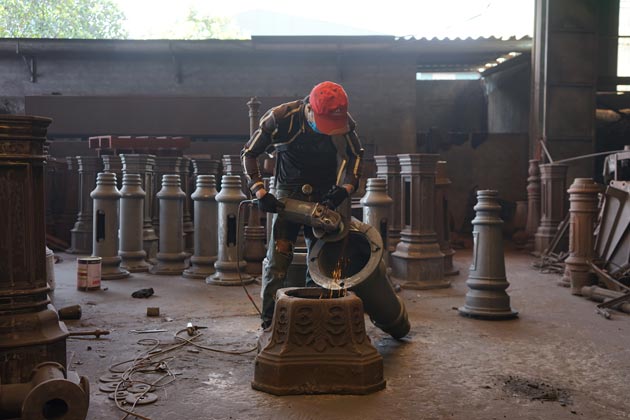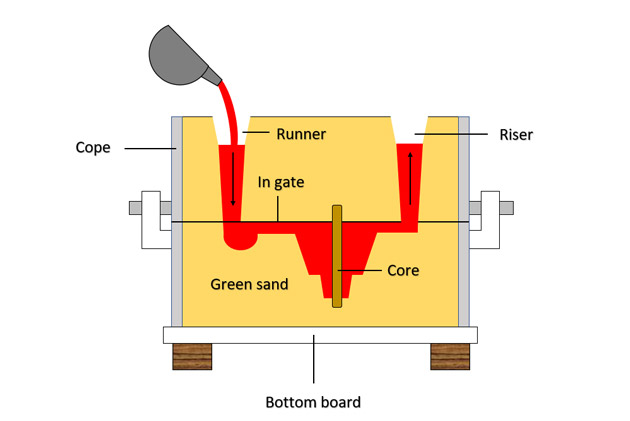Just How Aluminum Foundry Contributes to Improvements in Aerospace Design
Aluminum factories are indispensable to improvements in aerospace engineering. They generate light-weight, high-strength elements that are crucial for contemporary aircraft. With sophisticated casting strategies, these foundries develop complex geometries that boost architectural honesty. Furthermore, the advancement of exceptional Aluminum alloys supports the market's emphasis on gas efficiency and sustainability. Nonetheless, obstacles remain in the manufacturing process. Understanding these aspects discloses the extensive effect of Aluminum on air travel's future.
The Importance of Lightweight Products in Aerospace Style
As the aerospace market continues to develop, the value of light-weight products comes to be significantly evident. The demand for efficiency and sustainability drives engineers to focus on using products that reduce general weight without compromising architectural integrity. Lightweight materials, particularly Aluminum, play a vital function in enhancing gas efficiency, improving payload ability, and boosting the total performance of aircraft.
The integration of these materials enables for cutting-edge styles, allowing manufacturers to produce more aerodynamic shapes that can endure severe problems. The reduction in weight not just reduces operational expenses yet likewise contributes to a lowered ecological footprint, aligning with international efforts towards sustainability in aeronautics.
Advanced Spreading Techniques in Aluminum Foundries
Advanced casting strategies in Aluminum foundries play an important duty in aerospace design by allowing the manufacturing of precise and light-weight components. Technologies in mold design and accuracy casting procedures are vital in accomplishing perfect efficiency and structural integrity. Additionally, the development of lightweight alloys boosts the general performance and performance of aerospace applications.
Ingenious Mold Layout
Cutting-edge mold and mildew style plays an important duty in the performance and effectiveness of Aluminum shops, especially within the aerospace field. By leveraging sophisticated products and strategies, modern molds can be engineered to stand up to heats and pressures, guaranteeing peak performance during the spreading procedure. These layouts typically incorporate complicated geometries that enable for the production of lightweight yet structurally sound elements, important for aerospace applications. Furthermore, the usage of computer-aided design (CAD) software application helps with specific modeling, enabling factories to fine-tune and imitate mold and mildew layouts prior to physical manufacturing begins. This not only enhances the top quality of actors components but additionally reduces waste and lead times, leading to significant cost financial savings. In general, cutting-edge mold layout is a cornerstone of progression in Aluminum Foundry technology for aerospace engineering.
Precision Casting Procedures
The effectiveness of cutting-edge mold and mildew designs effortlessly integrates with accuracy casting processes, which are crucial for producing high-quality Aluminum elements in aerospace design. These processes, including sand casting, die casting, and financial investment spreading, guarantee the development of complex geometries with limited resistances. Advanced methods like vacuum cleaner spreading and stress die casting boost the stability and surface finish of the end products. Accuracy spreading minimizes material waste while maximizing the mechanical residential properties of Aluminum, critical for aerospace applications. Additionally, employing real-time surveillance and advanced simulation tools during the casting process allows for immediate changes, bring about boosted quality control. Collectively, these precision casting procedures position Aluminum factories at the leading edge of aerospace development, supporting the sector's need for reliability and efficiency.
Light-weight Alloy Advancement
As aerospace engineers look for to boost fuel effectiveness and performance, light-weight alloy development comes to be a necessary focus in Aluminum factories. These factories utilize sophisticated spreading techniques to create alloys that supply exceptional strength-to-weight ratios. Advancements in alloy structure, including the consolidation of aspects like lithium and magnesium, make it possible for the production of products that endure extreme conditions while lowering overall aircraft weight. Techniques such as die casting and financial investment casting facilitate the precision manufacturing of complex forms, which are critical for aerospace applications. Additionally, ongoing research aims to maximize these alloys for enhanced mechanical residential properties and raised sturdiness. By prioritizing light-weight alloy advancement, Aluminum shops considerably add to the development of aerospace engineering, leading the way for a lot more sustainable and reliable aircraft styles.

Enhancing Structural Stability With Aluminum Parts
Aluminum elements use significant advantages in boosting architectural honesty within aerospace design. Their light-weight nature adds to total efficiency while maintaining toughness, which is necessary for airplane performance. In addition, the stress resistance residential properties of Aluminum help ensure the durability and reliability of aerospace structures under different operational problems.
Lightweight Product Advantages
While traditional products typically compromise weight for toughness, utilizing Aluminum parts in aerospace design provides considerable benefits in architectural stability. Aluminum's lightweight nature adds to overall design performance, enabling more streamlined aircraft that consume less fuel, thus improving sustainability. The material's outstanding strength-to-weight ratio assurances that elements keep resilience without adding unnecessary mass. This top quality cultivates enhanced efficiency and dexterity in flight, in addition to enhanced payload abilities. Additionally, Aluminum's resistance to deterioration prolongs the lifespan of aerospace structures, reducing upkeep prices and boosting security. As suppliers progressively embrace Aluminum alloys, the aerospace industry experiences a transformative shift in the direction of extra effective and effective design remedies that prioritize both efficiency and ecological responsibility.
Tension Resistance Features
Various products have unique residential properties, Aluminum's outstanding stress and anxiety resistance stands out as an important aspect in boosting the structural integrity of aerospace elements. This resistance plays an essential duty in ensuring that aircraft can withstand numerous operational stresses, including tiredness, influence, and ecological conditions. Aluminum alloys, particularly engineered for aerospace applications, exhibit high tensile toughness while keeping light-weight helpful hints features, making it possible for designers to make a lot more reliable structures - Aluminum Foundry. Furthermore, the capability of Aluminum to sustain cyclic loading without substantial contortion adds to the durability and reliability of aerospace parts. As improvements proceed in Aluminum Foundry methods, the growth of stress-resistant Aluminum elements promises more enhancements in efficiency, safety and security, and effectiveness across the aerospace sector, solidifying Aluminum's role as a preferred product in contemporary design
Gas Performance Improvements Driven by Aluminum Innovations
As the aerospace market seeks to enhance gas efficiency, innovative uses Aluminum have actually become an essential remedy. Aluminum's lightweight nature especially reduces aircraft weight, enabling lower gas intake during trip. This reduction in weight is important, as even small decreases can lead to significant improvements in total fuel economy.
Advanced Aluminum alloys, made for boosted toughness and durability, make it possible for suppliers to create components that maintain structural stability while decreasing mass - Aluminum Foundry. Furthermore, the combination of Aluminum in airframes and engine parts facilitates enhanced aerodynamics, contributing to minimized drag and increased effectiveness
The fostering of Aluminum in aerospace not just fulfills the need for fuel-efficient style however also aligns with regulatory stress for lower emissions. As these advancements remain to advance, they play a substantial role in establishing brand-new benchmarks for fuel effectiveness, making certain that the aerospace sector can meet expanding financial and environmental obstacles.

The Function of Aluminum in Sustainable Aviation Practices
The increasing focus on sustainable aeronautics methods has actually placed Aluminum as a necessary material in the quest for greener aircraft layout. Recognized for its lightweight homes, Aluminum substantially lowers aircraft weight, leading to reduced fuel usage and emissions. Its recyclability better improves its sustainability account, as Aluminum can be reused indefinitely without loss of quality. This particular sustains a circular economy within the aviation sector, decreasing waste and source deficiency.
Advancements in Aluminum alloys have improved their toughness and deterioration resistance, allowing for longer service life and reduced maintenance demands. These innovations promote the growth of a lot more efficient aircraft frameworks, contributing to total sustainability efforts. Furthermore, Aluminum's thermal conductivity plays an important role in energy-efficient layouts, boosting systems such as warm exchangers. Jointly, these characteristics underscore Aluminum's pivotal function in advancing sustainable air travel, lining up with global campaigns focused on lowering the ecological impact of air traveling.
Challenges Faced by Aluminum Foundries in Aerospace Production
While Aluminum foundries play a additional hints crucial duty in aerospace manufacturing, they deal with considerable difficulties that can affect manufacturing performance and quality. One significant difficulty is the stringent high quality control requirements needed in the aerospace market. Any problem can endanger security and performance, necessitating rigorous assessment procedures that prolong manufacturing timelines. Furthermore, factories commonly emulate changing resources expenses, which can affect pricing and earnings. The complexity of Aluminum alloys used in aerospace applications further makes complex the production process, as precise formulations are important for attaining desired mechanical homes. Moreover, competent labor shortages hinder the ability to maintain top notch production degrees. Ecological regulations enforce constraints on discharges and waste management, requiring shops to invest in lasting methods, which can be cost-prohibitive. These factors jointly create a landscape where Aluminum factories must continually adjust to fulfill the developing needs of aerospace production while making certain safety and conformity.
Future Fads in Aluminum Applications for Aerospace Engineering
With developments in modern technology and enhancing demands for efficiency, the future of Aluminum applications in aerospace engineering is poised for substantial improvement. The assimilation of innovative Aluminum alloys and composites is anticipated to enhance strength-to-weight ratios, bring about more fuel-efficient aircraft styles. On top of that, advancements in additive manufacturing techniques will certainly enable the production of intricate Aluminum frameworks that were previously impossible, maximizing performance and reducing waste.

Lasting techniques will play an essential duty, with an expanding focus on reusing Aluminum to lessen environmental impact. The aerospace sector is most likely to accept smarter manufacturing procedures, such as automation and artificial knowledge, making certain greater quality and accuracy in Aluminum parts. Cooperations in between Aluminum shops and aerospace firms will cultivate study and growth, leading the way for brand-new applications that satisfy the strict requirements of contemporary aerospace engineering. Overall, the future looks assuring for Aluminum's function in forming the skies
Often Asked Concerns
What Are the Ecological Impacts of Aluminum Manufacturing in Aerospace?
The environmental influences of Aluminum production in aerospace include significant energy intake, greenhouse gas discharges, and environment disruption. In addition, mining processes can result in soil destruction and water contamination, raising worries about sustainability and ecological Your Domain Name equilibrium.
Just How Does Aluminum Compare to Other Materials in Aerospace Applications?
Aluminum supplies a distinct mix of light-weight buildings, rust resistance, and cost-effectiveness contrasted to various other products. Its high strength-to-weight proportion makes it particularly beneficial for aerospace applications, boosting gas performance and total performance in airplane layout.
What Certifications Do Aluminum Foundry Employees Demand for Aerospace Projects?
Aluminum Foundry employees need customized training in metallurgy and spreading strategies, together with expertise of aerospace industry requirements. Qualifications in quality control and safety and security protocols are also vital to assure conformity with rigorous aerospace project needs.
Are There Any Security Worry About Using Aluminum in Aerospace Engineering?
Security issues relating to Aluminum in aerospace design include sensitivity to fatigue, deterioration, and anxiety cracks. Correct therapy and alloy choice are vital to mitigate these dangers, making sure structural honesty and total security in aerospace applications.
Exactly How Does Aluminum Recycling Advantage the Aerospace Sector?
Aluminum reusing substantially profits the aerospace sector by minimizing material costs, reducing environmental influence, and conserving energy. This sustainable technique enhances the market's efficiency while promoting making use of light-weight, high-performance parts in airplane production.
Advanced casting techniques in Aluminum shops play a critical duty in aerospace engineering by enabling the manufacturing of specific and light-weight components. Innovative mold and mildew style plays a necessary function in the efficiency and effectiveness of Aluminum foundries, specifically within the aerospace field. As aerospace designers look for to improve gas performance and efficiency, lightweight alloy development comes to be a crucial emphasis in Aluminum foundries. Aluminum alloys, especially engineered for aerospace applications, show high tensile stamina while preserving light-weight attributes, enabling designers to design more effective structures. Collaborations in between Aluminum foundries and aerospace companies will cultivate research study and advancement, paving the means for brand-new applications that meet the rigorous requirements of modern aerospace engineering.